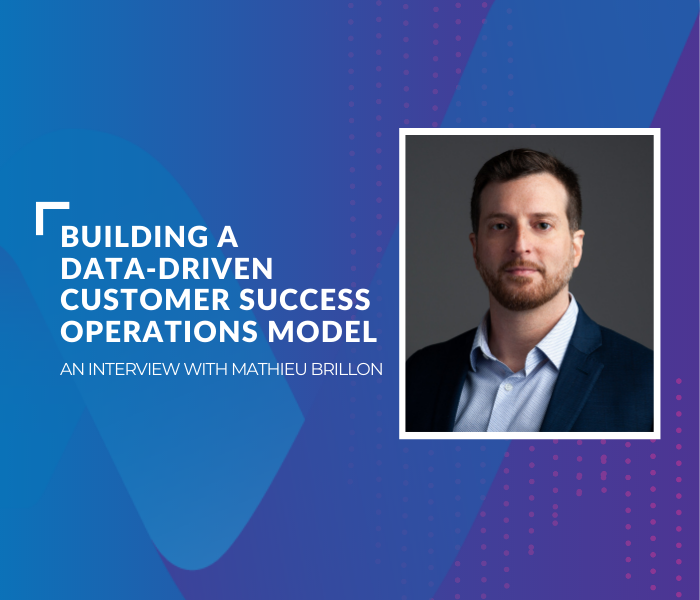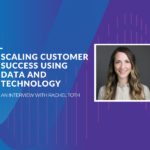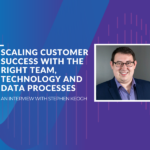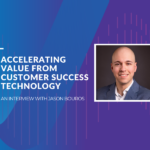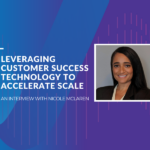Customer Success Is Nothing Without…
A best-in-class customer success strategy is nothing without an equally powerful technology and data model to operationalize it with. This fundamental operations layer is critical to the achievement of a strong customer success organization. Most software leaders understand this, but often struggle to create a true customer success operations function that creates recurring value and enables data-driven success for the customer.
So, what’s the secret to building a strong customer success operations model? To answer this question, I sat down with Mathieu Brillon, Solutions Delivery Director at Valuize. During our chat, we discussed Mathieu’s entry into the world of B2B software, how he leverages data to help his clients build robust customer success operations, and the most exciting opportunities he forecasts for today’s software leaders.
An Interview With Mathieu Brillon, Solutions Delivery Director At Valuize
Q: What was your first job?
A: “My first job out of university was in actuarial consulting. I studied mathematics during my undergraduate, so I was able to leverage that background to analyze and consult on pension plan administration systems. That’s the job where I was first exposed to working with operating systems. I was the company’s only ‘tech’ person at the time, so I helped solve the team’s problems related to systems and operations, and that really sparked my interest in the software industry.”
Q: How did you get started in customer success?
A: “When I moved to Calgary in 2013, I wanted to transition out of actuarial consulting and into the software industry. I started working for a learning management software company as their Director of Implementations. In that role, I realized that there was a need to split pre- and post- implementation work. I found that the project managers on my team were spending most of their time supporting the clients that were already active in the system, which I didn’t think made much sense. So I decided to create a new role, a client manager, that was responsible for taking over post-implementation services to help our customers be successful with our software. I didn’t know much about customer success management back then, but it turns out that the role I had created was closely aligned to what was emerging in the domain.”
Q: How have you seen the customer success domain change since starting your career? How do you think the domain will continue to evolve?
A: “I started getting more involved in the customer success community in Silicon Valley about seven years ago, when I began regularly attending conferences and industry events. Back then, the customer success community was very rudimentary and small. In fact, very few software companies were investing in customer success. Today, it seems that the majority of software companies have created dynamic customer success organizations. Customer success also seems to be gaining traction outside of the software industry, as more companies are discovering that similar processes can be applied to help the customer realize value.”
“My prediction is that the true nature of customer success will become more diluted, based on the origins of the domain. While traditional customer success was rooted in software-specific metrics (i.e. churn, expansion, etc.), you can’t apply the same principles to other industries with non-recurring revenue models. As we see this shift, I think the domain will branch out into something new and different in these industries, though the underlying purpose of customer success – to make customers successful with a product or service – will remain the same.”
Q: What company do you currently most admire when it comes to their customer success strategy and operations?
A: “Splunk. From the top down, Splunk identified that customer success was the way of the future. In some companies, we see that customer success is considered a ‘have-to-do’ rather than an initiative that can truly transform and accelerate an organization forward. Within Splunk, there’s the realization that customer success is what’s going to make them successful as an entire organization. Splunk works on cross-functional customer success projects where all leadership understands the day-to-day activities that enable their customers to be successful. It’s not just a post-sales function, it’s an across-the-board dedication to improving the customer journey.”
Q: How do you help your clients identify and prioritize the most relevant customer success metrics to measure?
A: “That’s a great question. One thing we do with our clients is create customer health scores that are aligned to specific, measurable outcomes that the customer is wanting to accomplish with the company’s products. These outcomes are pre-agreed upon between our client and the customer, and they work together to identify and track specific KPIs that directly relate to the outcomes the customer is wanting to achieve. By monitoring these outcome-based metrics, our clients are able to easily determine whether a customer is happy and healthy, or if there’s work to be done to ensure the customer is successful with the software.”
Q: What’s the most common mistake you see being made by companies failing to get value from their customer success technology investments?
A: “Many companies that implement customer success technology often think that the platform is going to tell their team what to do on a daily basis. While this can be achieved, depending on the software you’re using, you first need to implement and enable the functionality to do so. Therefore, the software implementation needs to be an expert-designed, well thought out initiative, and the accompanying strategy needs to be pressure-tested to support the successful adoption of the software.”
“On that note, another key reason for the failure to adopt customer success technology is a lack of support from the executive team. Customer success needs to be an organization-wide effort with top-down enablement in order for its potential to be fully realized.”
Q: What piece of advice would you give customer + revenue leaders that are interested in building and scaling a successful customer success organization?
A: “I think it’s important to recognize the fact that in order to be successful as a company, your customers need to be successful with your products and services that you offer. You’re not treating the customers as revenue, but instead, as partners. To do so, you need to understand your customer’s needs and the outcomes they’re looking to achieve with your products. Then, your entire organization needs to work together to help your customers be successful, which will in turn make your company successful.”
Q: When it comes to optimizing the retention and expansion of customers, what do you see as the biggest opportunities for customer + revenue leaders to pursue in 2021 and beyond?
A: “I’m a data guy, so at Valuize, our data model is driven by defining measurable customer outcomes and building strategies that achieve these outcomes for our clients. Given the industry we work in, I also think there’s a massive opportunity for customer success leaders to better leverage data science. Taking the advancements we’ve seen in AI and data science and applying them to customer success can help SaaS leaders identify customer trends and opportunities in real time. By doing so, we’ll start to get a much better understanding of the customer and enable them to accomplish outcomes that they might not have even realized they want to achieve.”
Q: Where should a company begin when building a customer success operations function?
A: “That’s been something I’ve been thinking about a lot recently. I believe that successful customer success operations start from the company’s strategy, but there also needs to be a strong data component that is driven by someone with extensive knowledge of data compliance and governance related to the customer. This is essential because customer success teams are continually ingesting data to make decisions from, and if you’re generating data that is unclean or inaccurate, your team won’t have the insights they need to make the customer successful. So at the highest level, there needs to be a leader who is responsible for both the deployment of the customer success strategy, as well as the customer success data management and operations.”
Bonus Q: What’s your favourite way to spend a Sunday?
A: “Waking up not too early, and spending the morning in bed, watching Youtube videos with my daughter and wife while drinking coffee. Then, getting up to make pancakes for everyone. Lazy sundays with my family are my ideal.”
Designing Your Data-Driven Model
Three takeaways really stood out from our conversation:
- Customer success needs to be a top-down, organization-wide effort that integrates the entire customer journey.
- There’s a massive, untapped opportunity to leverage AI and data science in the customer success domain to better understand and serve your customers.
- In order to be successful as a company, you need to treat your customers as true partners, not revenue streams. This starts with the joint creation of measurable outcomes that the customer can expect to achieve with your software.
With these insights in mind, you’re ready to start building and scaling an unstoppable customer success organization.
Contact Valuize to discover how you can create an industry-leading customer success operations function with expert guidance from Mathieu and his team.

